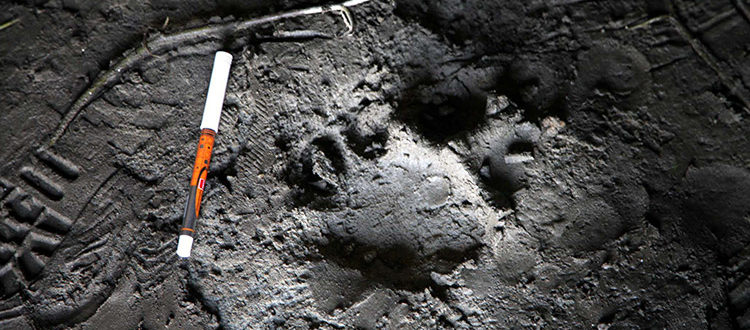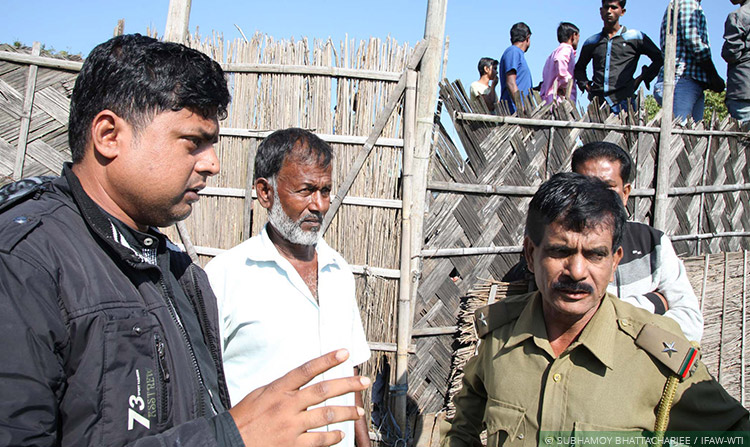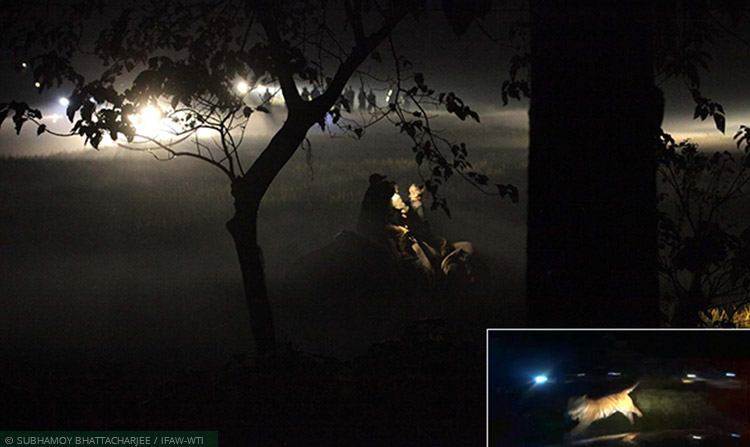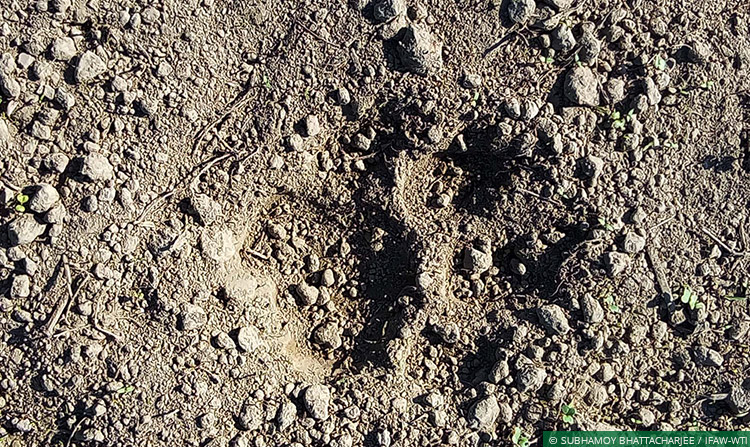The Tiger that Went Back
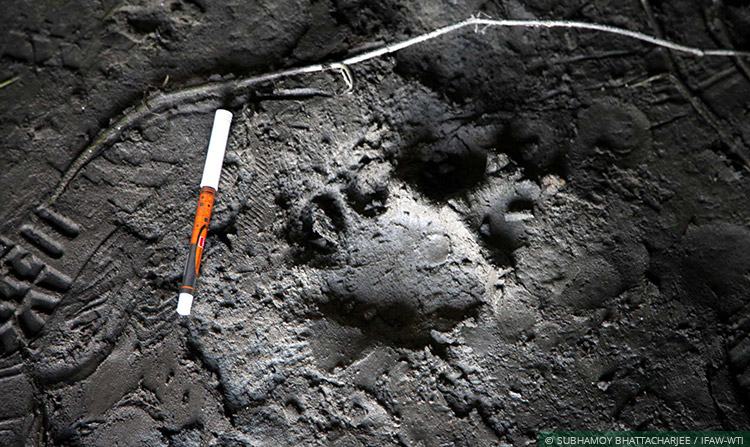 The tiger’s pugmark found near the walled compound at Dolabari.
The tiger’s pugmark found near the walled compound at Dolabari.
By Dr Samshul Ali
On November 24 the tiger filled its belly on a large buffalo it had killed at Bhumoraguri Chapori. That was the first evidence of its presence in the area.
This in itself was not unusual; the region sees tiger movement in the dry months, when waters levels recede and small islands arise within the breadth of the mighty Brahmaputra. But November 28 brought rather more alarming news.
I received a call at 6.30am from P Siva Kumar (IFS), Conservator of Forests, Assam Forest Department: a woman named Rabiya Khatun had been attacked near Dolabari as she was returning home after her morning prayers. The tiger had slipped away into the mist but was later spotted entering a large walled compound.
I gathered our Mobile Veterinary Service (MVS) team together and we rushed to the spot. It wasn’t very hard to find, given the immense crowd that had gathered there – always a problem during conflict situations, one that multiplies the threat to both animal and human life.
MVS veterinarian Dr Samshul Ali (left) gets the lay of the land from locals and forest department personnel.
I began gathering information from locals and forest department personnel and learned that after the attack – which happened, it must be clarified, not for predation but as part of the instinctive fight-or-flight response of the animal – the tiger had run off into a nearby paddy field. As the inevitable hue and cry occurred and a mob of villagers tried to corner it, it jumped into the walled compound nearby.
As a wildlife rescuer one has to react according to the parameters of a particular case; one can’t have a one-size-fits-all mentality.
Idrish Ali, the caretaker, had seen where the tiger had entered and there were pugmarks to corroborate his story. The walled area was about 10 bighas of which five bighas were being used to cultivate vegetables; the other five were covered in thick ulu and ikora grasses, into which the tiger had disappeared.
Planning a Tiger Drive
A core team was formed under the leadership of Rohini Saikia, Divisional Forest Officer of the Western Assam Wildlife Division. P Siva Kumar (Conservator of Forests); Kaushik Barua (Honorary Wildlife Warden – Guwahati); Jasim Ahmed (Assistant Conservator of Forests); wildlife volunteers Saurav Borkakati and Smarajit Ojha; personnel from WWF India; and of course our MVS team were all involved in the planning of the operation. Faqrul Islam of the civil police authority was in charge of crowd control operations.
All logistics including a trap cage, kumki elephants and earthmovers were kept in a state of readiness. Having assessed the situation, the team decided on the following essential courses of action:
- An emphasis on crowd management and sensitisation by the civil authorities
- The tiger would be contained in the walled area as far as possible during the day
- Deployment of a trap cage inside the compound without disturbing the animal
- Tight security both inside and outside the compound, so that the team could be alerted about any movement by the tiger
- All aspects of chemical immobilisation to be readied in case the tiger gets cornered or entraps itself in a suitable area
- Imposition of a curfew under Section 144 in the Dolabari area after dark, to minimise the chance of further conflict
- And finally, once the curfew was in effect, a concerted attempt to drive the tiger towards Bhumoraguri, the nearest spot from which it could enter Kaziranga National Park, Bura Chapori Wildlife Sanctuary, or Laokhowa Wildlife Sanctuary.
My mind went back to the last tiger conflict incident I had been involved in, where I had tranquilised a tigress at the NERIWALM campus just about half a kilometre away a few months back. The tigress was captured and released back into the wild without injury to it or the humans around it – the only true measure of success in a conflict situation.
Tranquilisation, however, wasn’t the optimal solution in the current scenario. There is a misconception that a tranquilised animal will drop where it stands the moment it is darted. In fact, the cocktail of immobilising drugs that we use takes a minimum of seven minutes to kick in. Darting a free ranging tiger is contraindicated because if one loses track of the animal, it could very well die somewhere out of sight.
As a wildlife rescuer one has to react according to the parameters of a particular case; one can’t have a one-size-fits-all mentality. So in this instance, we waited for nightfall. We did place a trap cage inside the compound, but took care not to disturb the specific area the tiger was suspected to be in. Needlessly escalating the situation while there were so many people around could have had disastrous consequences for both the humans and the animal involved.
The Largest Tiger Ever
At 7.30pm an announcement was made over a public address system and the crowd began to disperse. The curfew was now in effect. At around 9.00pm Kaushik Barua and I entered the area on an earthmover vehicle, tranquiliser guns at the ready. Accompanying us were Saurav Borkataki and Smarajit Ojha, each with an armed forest guard, on two kumki elephants. DFO Rohini Saikia, CF Siva Kumar and ACF Jasim Ahmed formed the ground control team, coordinating the wide-angle aspects of the operation.
Kumki elephants and a JCB earthmover were deployed at night to drive the tiger out of the Dolabari area towards the nearby forests. (Inset: The tiger glimpsed in a video captured during the night drive operation.)
But the tiger wasn’t about to make things easy for us. No sooner had we started our combing operation than it exited the walled compound to a nearby paddy field. We were forced to leave the JCB and proceed towards it on two elephants.
Approaching an angry tiger on elephant back is never a good idea but the situation demanded the risk. As the elephants moved forward, the tiger turned towards us.
Approaching an angry tiger on elephant back is never a good idea but the situation demanded the risk. As the elephants moved forward, the tiger turned towards us. The elephant I was on was bang in front of it. I saw its massive head as it crouched, its sparkling canines and fully extended forelimbs as it leaped… then at the sound of a blank fire it changed direction and bounded off in the opposite direction.
It jumped onto P Sivakumar’s forest department vehicle, biting at the bonnet and smashing the windshield. Framed in the vehicle’s headlights it appeared to be massive, a full grown adult male, 300kg at the minimum. As we gathered together all anyone could say was “Iman dangor baagh jibonot dekha nai” (I’ve never seen such a massive tiger in my life)!
We learned that the tiger had moved towards the Batamari area where it had attacked a young man who was moving about in spite of the curfew. We searched the area for another couple of hours before dispersing for the night. Forest department personnel found pugmarks on the banks of the Brahmaputra near Maithani early next morning, which suggested that the drive had been successful and that the tiger had moved towards Bura Chapori WLS.
Pugmarks on the banks of the Brahmaputra confirmed that the tiger had moved out of human-use areas and back to the wild.
We returned to the Dolabari-Batamari area however, and conducted a thorough combing operation. Having found no sign of the animal, we declared the area a tiger free zone and reassured local communities that the tiger was no longer present in that territory.
On November 30 forest officials confirmed that the tiger had indeed returned to Bura Chapori WLS. It has since entered and been seen moving about in the 6th Addition to Kaziranga National Park.
The author is a veterinary surgeon with the Centre for Wildlife Rehabilitation and Conservation.

